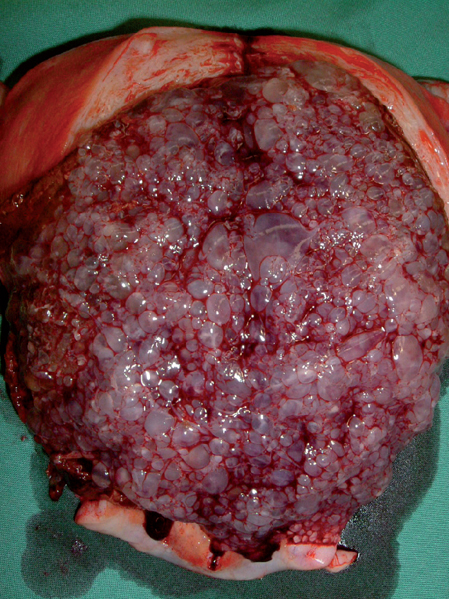46 Gestational Trophoblastic Disease: Molar Pregnancy
Robert L. Barbieri
Definition
Gestational trophoblastic diseases (GTDs) are a group of five interrelated disorders of trophoblast epithelium of the placenta, which lead to placental tumors. Of the five forms of GTD, two forms, complete hydatidiform mole (Fig. 46.1) and partial hydatidiform mole, tend to have a benign course and are cured in the majority of cases by evacuating the uterus with a suction dilation and curettage. Three forms of GTD are malignant: invasive mole, choriocarcinoma, and placenta site trophoblastic tumor. Malignant forms of GTD are referred to as gestational trophoblastic neoplasia (GTN) and are typically treated with chemotherapy and hysterectomy if appropriate. Malignant forms of GTD most commonly arise from the malignant transformation of a complete hydatidiform mole, but they may occur following any type of gestation including term pregnancy, ectopic pregnancy, or spontaneous abortion. Malignant GTD is curable in most cases.

Fig. 46.1 Gross pathology of a complete hydatidiform mole in a hysterectomy specimen From Sidney Southwest Arpa Health Service New South Wales, Australia
Hydatidiform mole, which may be complete or partial, is the most common type of GTD and represents over 80% of all cases. This chapter will focus on these two presentations of the disease. Malignant GTD will be reviewed briefy at the end of the chapter.
Hydatidiform Mole
Etiology
All hydatidiform moles have abnormal DNA complements, which are the result of abnormal fertilization of an oocyte (Table 46.1). In the case of complete hydatidiform mole, an empty oocyte is fertilized by a sperm that duplicates its chromosome material, or, less commonly, an empty oocyte is fertilized of by two sperm. A partial mole arises from the fertilization of an oocyte by two sperm resulting in triploidy.
| Complete hydatidiform mole | Partial hydatidiform mole | |
| Karyotype | 90% of cases 46,XX; 10% of cases 46,XY | 90% of cases triploid—69,XXX or 69,XXY |
| Source of sex chromosomes | All sex chromosomes are of paternal origin | One set of chromosomes are of maternal origin, and two sets of paternal origin |
| Villi swelling | Diffuse swelling of all villi | Focal swelling, scalloped villi |
| Trophoblast hyperplasia | Marked, circumferential around villi | Minimal, focal |
| Fetal tissue | None | Present |
| Immunocytochemistry | Intense staining for human chorionic gonadotropin | Intense staining for placental alkaline phosphatase |
| Malignant sequelae | About 20% of cases | 2% of cases |

Fig. 46.2 Ultrasonographic presentation of complete hydatidi-form mole
Diagnosis and Initial Monitoring of Disease Activity
In countries where diagnostic ultrasonography is widely available, most hydatidiform moles are diagnosed by this technique in the first trimester of pregnancy. Almost all women with hydatidiform mole present with first trimester uterine bleeding. Due to the bleeding, pelvic ultrasound examination is routinely obtained to assess the status of the pregnancy. Complete hydatidiform mole is diagnosed when the ultrasound scan demonstrates the characteristic “snow storm” of multiple small cystic structures, which is the ultrasonographic presentation of multiple swollen villi (Fig. 46.2). Partial hydatidiform mole typically are thought to be missed abortions on ultrasonography, but when the uterus is evacuated, full pathological analysis demonstrates the presence of a mole. Women with suspected molar pregnancy should have a suction dilation and curettage to obtain placental tissue for final pathological diagnosis. In 80% of cases of complete hydatidiform mole, suction dilation and curettage cures the disease. In 20% of cases the disease persists requiring later chemotherapy. In 98% of cases of partial hydatidiform mole, suction dilation and curettage cures the disease.
After dilation and curettage, serum human chorionic gonadotropin (HCG) levels are followed weekly. An HCG level that reaches less than 5 mIU/mL indicates that the disease is cured. Following evacuation of a complete or partial hydatidiform mole, on average it takes 100 days or 60 days, respectively, for the HCG to reach less than 5 mIU/mL. (After a normal pregnancy, HCG levels return to normal after 4 weeks.) An HCG level that does not decrease (plateau of HCG for 3 weeks), or increases by 10%, or remains at greater than 5 mIU/mL after 26 weeks of measurement indicates the presence of persistent hydatidiform mole. In this situation, 75% of the cases represent an invasive mole and 25% represent choriocarcinoma.
Pathology
Complete hydatidiform moles are characterized by diffuse and marked swelling of the villi. Partial hydatidiform moles are characterized by focal swelling of the villi and the presence of embryonic tissue (Table 46.1).
Prevalence and Epidemiology
Stay updated, free articles. Join our Telegram channel

Full access? Get Clinical Tree


